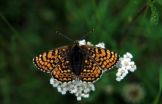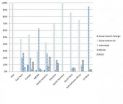(Press-News.org) The Glanville fritillary has long been an internationally known model species for ecology and evolutionary biology, whose population biology has been studied on the Åland Islands for more than twenty years. Now the species has become even more significant. Led by Research Professor Ilkka Hanski, the Metapopulation Research Group (MRG) at the University of Helsinki has sequenced the full genome of the Glanville fritillary together with three groups from the Institute of Biotechnology at the same university.
Before the sequencing of the Glanville fritillary genome, which is approximately 390 million base pairs long, the only genomes sequenced in Finland were those of viruses and bacteria. After the silk moth and longwing, the Glanville fritillary is now the third species of butterfly for which both the sequence of its full genome and a high-resolution genetic map is available. The map displays the location of approximately 16,000 genes in the species' 31 chromosomes.
The study also confirms the hypothesis that the ancestral lepidopteran species had 31 chromosomes, as originally proposed by Esko Suomalainen, professor of genetics at the University of Helsinki in the 1960s.
"The most astonishing thing is that it seems like the genes have stayed in the same chromosomes practically throughout the evolutionary history of butterflies –at least for 140 million years. Such stability is nearly unique among all organisms. What is even more surprising is that even though some chromosomes have fused during the lepidopteran evolution, the genes remain on their own side of the chromosome even after chromosomal fusions," explains group leader Mikko Frilander of the Institute of Biotechnology, who participated in the study.
Originally consisting of ecologists, MRG focused heavily on genome sequencing, as its objective is to combine genetic and genomic research with its strong ecological and evolutionary biological research.
"We want the Glanville fritillary to become a new model species for integrative biology. The next challenge is to get more biologists interested in the species," states Research Professor Ilkka Hanski.
The sequencing of the Glanville fritillary genome was a four-year project, funded by the European Research Council and the Academy of Finland.
Most of the sequencing was conducted on the Viikki Campus, at the Institute of Biotechnology of the University of Helsinki, under the supervision of Petri Auvinen. Genome assembly was the responsibility of Panu Somervuo of MRG and Leena Salmela from the Department of Computer Science. Gene annotation and predicting their function was conducted by Virpi Ahola from MRG together with Liisa Holm, professor in bioinformatics, and Patrik Koskinen.
The high-resolution genetic map for the Glanville fritillary was constructed using a tool developed by Pasi Rastas, from MRG.
INFORMATION:
Glanville fritillary genome sequenced at the University of Helsinki
2014-09-05
ELSE PRESS RELEASES FROM THIS DATE:
Near-extinct African amphibians 'invisible' under climate change
2014-09-05
An international team of researchers has found that the majority of threatened species are 'invisible' when using modern methods to predict species distributions under climate change.
Using African amphibians as a case study, the researchers found that more than 90 per cent of the species listed as threatened on The IUCN Red List of Threatened Species are omitted by the most popular tools for species distribution modelling.
The study, led by researchers from the Universities of York and Copenhagen and the United Nations Environment Programme World Conservation Monitoring ...
Caffeine therapy for apnea of prematurity does not have long-term harmful effects on sleep
2014-09-05
Caffeine therapy for apnea of prematurity has no long-term harmful effects on sleep or control of breathing, according to a new study of 201 preterm children assessed at ages 5-12, the first study in humans to examine the long-term effects of neonatal caffeine treatment on sleep regulation and ventilatory control.
"Animal studies have suggested that administration of neonatal caffeine to premature infants, while improving survival and other outcomes, may have long-term detrimental effects on sleep and control of breathing during sleep," said lead author Carole L. Marcus, ...
Research finds no association between wearing a bra and breast cancer
2014-09-05
PHILADELPHIA — A population-based case-control study found no association between bra wearing and increased breast cancer risk among postmenopausal women, according to research published in Cancer Epidemiology, Biomarkers & Prevention, a journal of the American Association for Cancer Research.
"There have been some concerns that one of the reasons why breast cancer may be more common in developed countries compared with developing countries is differences in bra-wearing patterns," said Lu Chen, MPH, a researcher in the Public Health Sciences Division at Fred Hutchinson ...
Magnetic nanocubes self-assemble into helical superstructures
2014-09-05
Materials made from nanoparticles hold promise for myriad applications, from improved solar energy production to perfect touch screens. The challenge in creating these wonder-materials is organizing the nanoparticles into orderly arrangements.
Nanoparticles of magnetite, the most abundant magnetic material on earth, are found in living organisms from bacteria to birds. Nanocrystals of magnetite self-assemble into fine compass needles in the organism that help it to navigate.
Collaborating with nanochemists led by Rafal Klajn at the Weizmann Institute of Science in Israel, ...
A lifetime of outdoor activity may contribute to common eye disease; sunglasses may help
2014-09-04
BOSTON (Sept. 4, 2014) — Residential geography, time spent in the sun, and whether or not sunglasses are worn may help explain why some people develop exfoliation syndrome (XFS), an eye condition that is a leading cause of secondary open-angle glaucoma and can lead to an increased risk of cataract and cataract surgery complications, according to a study published on Sept. 4 in JAMA, Ophthalmology.
Despite improvements in understanding the cause of this common yet life-altering condition, more work needs to be done. "The discovery that common genetic variants in the lysyl ...
NASA sees Dolly's remnants bringing showers to the Rio Grande Valley
2014-09-04
Tropical Storm Dolly fizzled out quickly on September 3 after making landfall in eastern Mexico, and NASA's Aqua satellite saw some of the remnants moving into southern Texas. NASA's TRMM satellite analyzed the rainfall occurring in the storm as it was approaching landfall.
NASA's Aqua satellite captured the remnants of Tropical Depression Dolly over northeastern Mexico on Sept. 3 at 19:40 UTC (3:40 p.m. EDT). The image, captured by the Moderate Resolution Imaging Spectroradiometer or MODIS instrument showed the center of Dolly over northeastern Mexico with a band of thunderstorms ...
Hurricane Norbert pinwheels in NASA satellite imagery
2014-09-04
The Eastern Pacific's Hurricane Norbert resembled a pinwheel in an image from NASA's Terra satellite as bands of thunderstorms spiraled into the center. NASA's Global Precipitation Measurement or GPM mission has helped forecasters see that Norbert has lost some of its organization early on September 4.
The MODIS instrument or Moderate Resolution Imaging Spectroradiometer aboard NASA's Terra satellite captured a visible picture of Tropical Storm Norbert on Sept. 4 at 2:15 p.m. EDT when it resembled a pinwheel. The western bands of Norbert were moving over Socorro Island, ...
Climate-smart agriculture requires three-pronged global research agenda
2014-09-04
Faced with climate change and diminishing opportunities to expand productive agricultural acreage, the world needs to invest in a global research agenda addressing farm and food systems, landscape and regional issues and institutional and policy matters if it is to meet the growing worldwide demand for food, fiber and fuel, suggests an international team of researchers.
In a paper appearing online in the journal Agriculture and Food Security, the authors summarize the findings of the second international Climate Smart Agriculture conference held in March 2013 at UC Davis.
"Climate-smart ...
News media losing role as gatekeepers to new 'social mediators' on Twitter, study finds
2014-09-04
The U.S. government is doing a better job of communicating on Twitter with people in sensitive areas like the Middle East and North Africa without the participation of media organizations, according to a study co-authored by a University of Georgia researcher.
The study looked at the U.S. State Department's use of social media and identified key actors who drive its messages to audiences around the world. In particular, it examined the role played by news media and the government in bridging the State Department communication with people domestically and internationally. ...
Scientists identify rare stem cells that hold potential for infertility treatments
2014-09-04
DALLAS – Sept. 4, 2014 – Rare stem cells in testis that produce a biomarker protein called PAX7 help give rise to new sperm cells — and may hold a key to restoring fertility, research by scientists at UT Southwestern Medical Center suggests.
Researchers studying infertility in mouse models found that, unlike similar types of cells that develop into sperm, the stem cells that express PAX7 can survive treatment with toxic drugs and radiation. If the findings hold true in people, they eventually could lead to new strategies to restore or protect fertility in men undergoing ...





